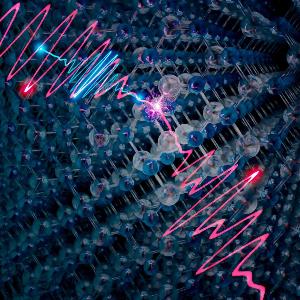Laser physics: Exploration of new frequency frontiers
11 Jan 2022
An international team under the leadership of LMU physicist Prof. Matthias Kling reports in Optica.
11 Jan 2022
An international team under the leadership of LMU physicist Prof. Matthias Kling reports in Optica.

The unfolding ultrafast dynamics is interrogated by field-sampling spectroscopy. | © RMT Bergues
If physicists want to learn more about the dynamics of electrons in solids, they probe them with electromagnetic fields. When matter is irradiated by ultrashort laser pulses, excited electrons scatter on femtosecond timescales (a femtosecond is a millionth of a billionth of a second). Information about the scattering and other fast processes in the material can be extracted from the wave characteristics of transmitted or reflected light fields, in so-called field-resolved spectroscopy. Some of this information, however, was not accessible. Field-resolved experiments had covered only frequencies below 50 terahertz.
An international team around LMU physicist Matthias Kling has now extended the method to a range of 50-100 terahertz. With the doubling of the maximum frequency the researchers gained new insight into light-induced processes in solids. “The advantage of measurements in this extended frequency range is that it is free of other resonances. This permits to accurately monitor the response of free electrons in the materials”, explains Marcel Neuhaus, first author of the study. This way, the technique provided a time resolution of electron dynamics in solids below 10 femtoseconds.
Marcel Neuhaus, Johannes Schötz, Mario Aulich, Anchit Srivastava, Džiugas Kimbaras, Valerie Smejkal, Vladimir Pervak, Meshaal Alharbi, Abdallah M. Azzeer, Florian Libisch, Christoph Lemell, Joachim Burgdörfer, Zilong Wang, Matthias F. Kling. Transient field-resolved reflectometry at 50-100 THz. Optica, 2022.
For more information click here.